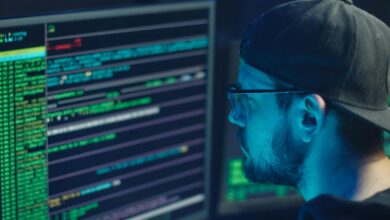How to Choose the Right Software for Cybersecurity: A Comprehensive Guide

In today’s digital age, cybersecurity is no longer optional—it’s a necessity. With cyber threats evolving in complexity and frequency, selecting the right cybersecurity software is critical to protecting your data, systems, and reputation. Whether you’re an individual, small business owner, or IT professional managing enterprise-level security, choosing the appropriate tools can make all the difference. In this guide, we’ll walk you through the key steps and considerations for selecting the right cybersecurity software.
1. Assess Your Security Needs
Before diving into product comparisons, evaluate your specific requirements:
- Type of User: Are you securing a personal device, a small business network, or an enterprise infrastructure?
- Data Sensitivity: What kind of data are you protecting (e.g., financial records, customer information, intellectual property)?
- Threat Landscape: Identify the types of threats most relevant to your environment (e.g., malware, phishing, ransomware).
- Compliance Requirements: Certain industries (e.g., healthcare, finance) must adhere to regulations like HIPAA, GDPR, or PCI-DSS, which dictate specific security measures.
Understanding your needs will help narrow down the options and ensure you invest in solutions tailored to your situation.
2. Understand Different Types of Cybersecurity Software
Cybersecurity encompasses various tools designed to address different aspects of protection. Familiarize yourself with these categories:
Antivirus/Anti-Malware
Protects against viruses, worms, Trojans, spyware, and other malicious software. Essential for endpoint devices like laptops and desktops.
Firewalls
Monitors and controls incoming and outgoing network traffic based on predefined rules. Acts as a barrier between trusted and untrusted networks.
Endpoint Detection and Response (EDR)
Provides real-time monitoring and response capabilities for endpoints (e.g., computers, servers). Ideal for detecting advanced persistent threats (APTs).
Email Security
Filters out phishing attempts, spam, and malicious attachments. Critical since email remains a primary attack vector.
Encryption Tools
Secures sensitive data by converting it into unreadable formats unless decrypted with a key. Useful for protecting stored files and communications.
Identity and Access Management (IAM)
Manages user identities and access permissions, ensuring only authorized individuals can access resources.
Backup and Disaster Recovery
Ensures data can be restored after incidents like ransomware attacks or hardware failures.
Vulnerability Scanners
Identifies weaknesses in systems, applications, or networks before attackers exploit them.
Each type serves a unique purpose, so consider combining multiple tools for comprehensive coverage.
3. Evaluate Key Features
When comparing cybersecurity software, look for the following features:
Real-Time Protection
The ability to detect and block threats instantly is crucial. Ensure the software offers continuous scanning and automatic updates.
User-Friendly Interface
Complex interfaces can hinder adoption. Opt for intuitive designs that simplify configuration and management.
Scalability
For businesses, choose solutions that grow with your organization without requiring frequent replacements.
Cross-Platform Compatibility
Ensure the software works across all devices and operating systems used within your environment (Windows, macOS, Linux, mobile platforms).
Cloud Integration
If you rely on cloud services, select software that supports cloud-based environments and hybrid infrastructures.
Customization Options
Tailor the software to meet your unique needs, such as setting custom alert thresholds or creating whitelists/blacklists.
Reporting and Analytics
Detailed logs and reports help track performance, identify vulnerabilities, and demonstrate compliance during audits.
4. Research Vendor Reputation
Not all cybersecurity vendors are created equal. Investigate potential providers using these criteria:
Track Record
Look for established companies with a proven history of delivering reliable products. Check reviews, case studies, and testimonials.
Certifications and Awards
Reputable vendors often hold certifications (e.g., ISO 27001) or receive industry recognition for innovation and effectiveness.
Customer Support
Reliable technical support is essential when issues arise. Test their responsiveness and availability before committing.
Update Frequency
Cyber threats evolve rapidly, so choose vendors that release regular updates and patches to stay ahead of emerging risks.
Community Feedback
Explore forums, social media, and review platforms like G2 or Capterra to gauge user experiences and satisfaction levels.
5. Consider Cost vs. Value
While budget constraints are inevitable, prioritize value over cost alone. Here’s how to strike the right balance:
Total Cost of Ownership (TCO)
Factor in licensing fees, maintenance costs, training expenses, and any additional charges for premium features.
Free Trials and Demos
Take advantage of free trials or demos to test functionality and compatibility before purchasing.
Open Source Alternatives
For smaller budgets, open-source solutions like Snort (intrusion detection) or VeraCrypt (encryption) offer robust features at no cost—but may require more technical expertise.
Return on Investment (ROI)
Weigh the long-term benefits against upfront costs. Investing in high-quality software now can save significant money by preventing costly breaches later.
6. Prioritize Ease of Deployment and Maintenance
Implementing new software should not disrupt operations. Consider these factors:
Ease of Installation
Choose solutions that integrate seamlessly into existing workflows without extensive downtime.
Automation Capabilities
Automated tasks like patch management, threat detection, and backups reduce manual effort and human error.
Centralized Management
For organizations, centralized dashboards streamline oversight and reduce administrative overhead.
Minimal Resource Consumption
Ensure the software doesn’t slow down devices or overload servers, especially in resource-constrained environments.
7. Plan for Future-Proofing
Cybersecurity is an ongoing battle, so prepare for tomorrow’s challenges today:
AI and Machine Learning
Advanced technologies enhance threat detection accuracy and adaptability. Look for AI-driven features that predict and prevent attacks.
Zero Trust Architecture
Adopt solutions aligned with zero trust principles, where every user and device must verify identity continuously.
IoT and Remote Work Support
With the rise of remote work and Internet of Things (IoT) devices, ensure the software protects decentralized networks effectively.
Integration with Emerging Technologies
Consider compatibility with blockchain, quantum computing, or 5G as they become mainstream.
8. Test Before Committing
Before finalizing your decision, conduct thorough testing:
- Run simulations to see how the software handles common threats.
- Simulate recovery scenarios to confirm backup and disaster recovery capabilities.
- Involve stakeholders to gather feedback on usability and performance.
9. Stay Educated and Proactive
Even the best software requires vigilant oversight. Complement your investment with:
- Regular employee training to prevent social engineering attacks.
- Periodic audits to assess system vulnerabilities.
- Staying informed about the latest trends and threats in cybersecurity.




